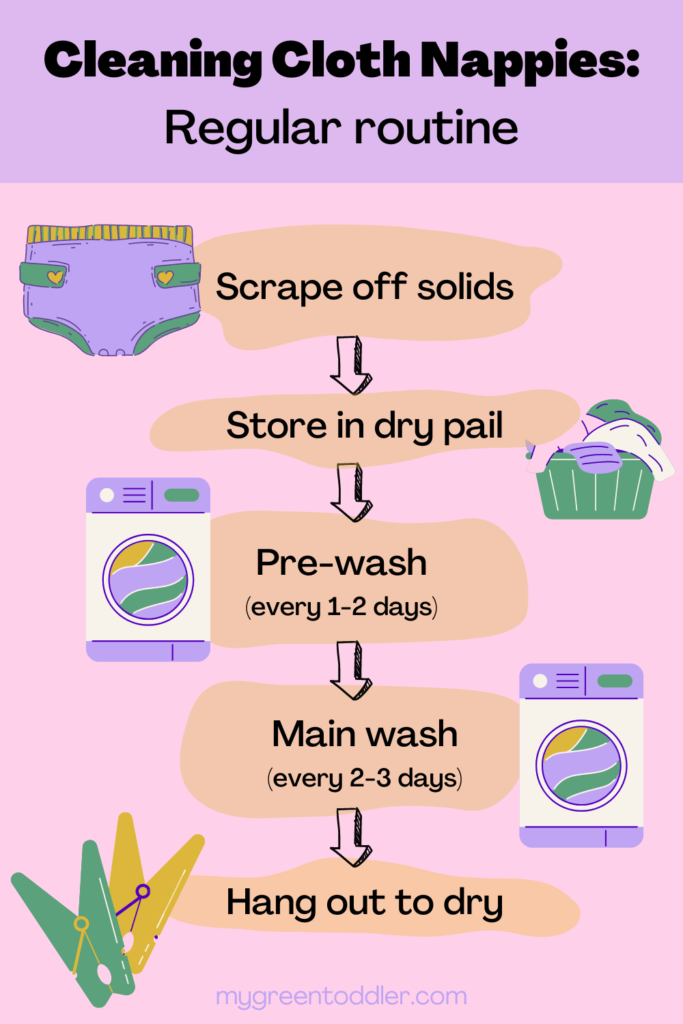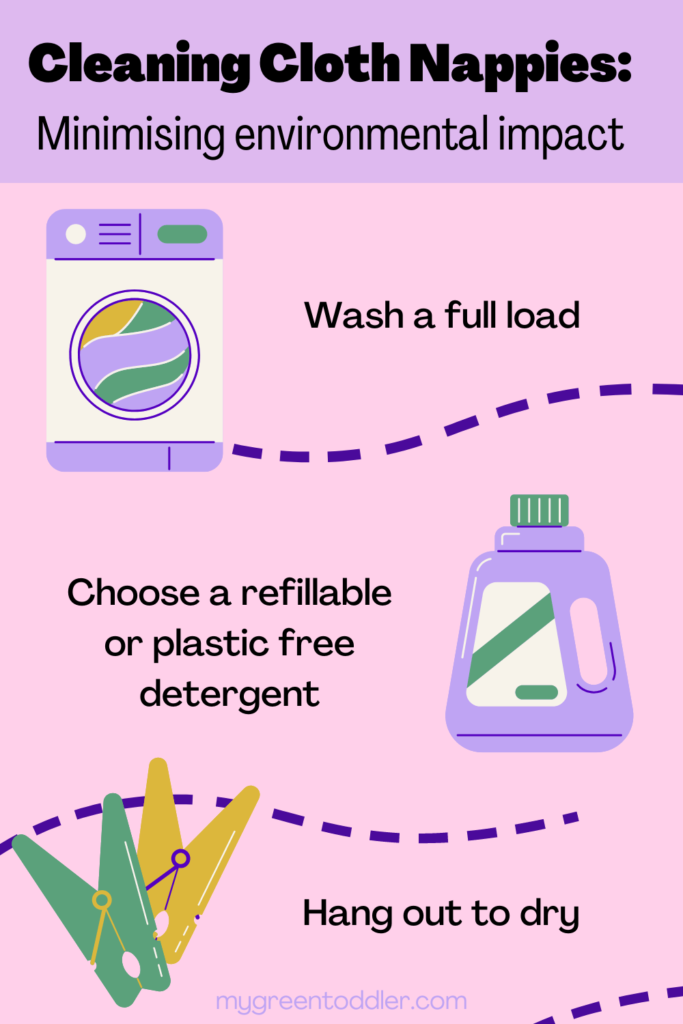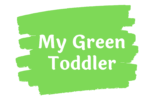It can be a daunting task for parents to switch from disposable nappies to reusable cloth nappies. With so many questions around the best way to handle these reusable items, it can be hard to know where to start. In this article, cloth nappy experts provide answers to the most common questions about cleaning cloth nappies so you can feel confident in ensuring your baby’s nappies are clean and hygienic.
Your Questions About Cleaning Cloth Nappies
Can I put poopy nappies in the washing machine?
Kam Andrews from The Nappy Guru advises not to. “Yes you can but do you want to? I personally preferred not to. Breast fed poo is known to dissolve completely in hot water but I recommend that if it’s quite a large amount and can shake/scrape majority of it– then do it! It’s a great habit to get into anyway.”
Leesa Mills from Darlings Down Under agrees. “Empty solids into the toilet. Unless baby is still on milk – then straight into the dry pail.”
How do you wash cloth nappies?
Mills explains her regular routine.
“After removing solids, do a daily (or second day at most) short wash cycle on your washing machine. Around 30 minutes is fine. If you use a dedicated night nappy then a daily prewash is essential and around an hour is a good length. 40 or 60 degrees and half a dose of detergent is ideal.
Do a main wash of all prewashed nappies no less than every 3rd day. (I opt for every second day but you may want to main wash daily if you have a limited supply of nappies). Your main wash should be the longest cycle on your machine, 2 ½ to 3ish hours is generally a good amount of time. 40 or 60 degrees with a full dose of detergent for a heavily soiled load is recommended.
Dry nappies on your clothes line. Inserts can be dried in the dryer as per manufacturers directions.”

Why don’t you soak cloth nappies?
Soaking cloth nappies is old fashioned and is no longer recommended. Andrews tells us why.
“There are a number of reasons but mainly:
- It creates a breeding ground for bacteria
- Modern Cloth Nappy fabrics like PUL (water proofing layer) and elastics can degrade with prolonged or frequent soaking
- It could become a drowning hazard
- Can be heavy to lift
- Current formula of Napisan does not contain the sanitising agents any more like it did years back
If you still want to soak – keep it short to about max 1 hour with any items that don’t have elastics or water proofing layers.”
If you’ve heard of dry pailing and not known the meaning, it is the alternative to soaking cloth nappies. Instead of soaking nappies while they wait to be washed, nappies are placed in a dry container to avoid the risks outlined by Andrews. According to Mills, the ideal dry pail is an airy basket.
Which washing detergent is best for cloth nappies?
Choosing an appropriate washing detergent is critical to properly cleaning cloth nappies without damaging them.
Catia Steel from Love & Homemaking gives her tips on choosing a suitable laundry detergent.
“When it comes to choosing a detergent for cloth diapers, the key is to look for one that is free of fabric softeners and brighteners. Homemade laundry soap, soap nuts, or “all-natural bar soap” are all hard no’s when it comes to cloth diapers, too.
It’s also important to use detergents that are high efficiency (HE) machine compatible if you use an HE machine since they are low sudsing, which will prevent buildup issues.”
Can I wash cloth nappies with other clothes?
Yes! Andrews recommends adding small items (baby clothes are perfect!) to make up a full load (2/3 to 3/4 full when wet).
What should you do if cloth nappies start smelling?
Mills is adamant that cloth nappies should not smell. She suggests that if you are getting a strong ammonia smell, you need to reassess your washing routine or seek help from someone in the cloth nappy industry.
Steel says the same. “It simply means you haven’t cracked the correct laundry routine… yet.”
“What’s important is that you continuously adjust your washing routine until your diapers remain un-smelly long-term. It’s a trial-and-error approach. At any hint of any smells appearing, re-diagnose the cause and adjust your wash routine.”
Steel goes on to explain some of the common causes of smelly cloth nappies.
“The first step in tackling the stink is to figure out what type of smell you’re dealing with. Is it a barnyard odor? A pungent ammonia smell? Or does the smell only occur when the diapers are wet or fresh out of the dryer? Understanding the behavior of the smell can help you pinpoint its root cause.
For example, barnyard smells are most often caused by not using enough detergent during the washing process. Stiff, smelly, and dingy diapers are usually due to hard water. You might even have a combination of issues to work through.”
See Steel’s article on how to fix smelly nappies and if that fails, how to deep clean or strip cloth nappies if necessary.
How do you deep clean cloth nappies?
Sometimes even after perfecting cleaning cloth nappies, traces of urine, faeces and detergent an build up which can cause a smell or reduce absorbency. Or perhaps you’re getting nappies second hand and want to be sure they’re clean before using on your baby.
Steel describes her preferred methods of deep cleaning cloth nappies.
“My personal favorite is the “wash and sun” method, where I wash them 3-5 times on a hot and long cycle, without detergent, then lay them out in the hot sun to dry for a few hours.
Another super effective method is the “soak and wash” method, where you add either vinegar or baking soda (don’t combine them) to hot water and allow cloth diapers to soak in this solution overnight. Then, wash them without detergent on a short, hot cycle in the laundry machine before washing them again with detergent.
Stripping can be effective, but it’s an extremely harsh process for your cloth diapers and should be avoided if possible. It involves using a heavy-duty detergent, multiple hot washes, and often an additional stripping agent such as RLR. If you do this, be sure to follow with a couple of hot washes with no detergent to completely remove any residual cleaning agents.”
Rachel Nelson from Seam Whisperer has a handy function on her washing machine.
“When I need to deep clean my diapers I first start with doing an extra wash when they are already clean. If they need more, then I try the “sanitise” setting on my machine which steams them. But I don’t do this on PUL or elastics; they will get ruined.”
How can I minimise the environmental impact of frequently washing nappies?

- Once nappies have been pre-washed, additional clothes can be added to make up a full load. This will minimise water and energy use.
- Hang nappies out to dry instead of using a dryer. Not only is this better for the environment but it will prevent damage to water proof layers.
- Find a suitable laundry detergent (refer to Steel’s advice) that comes plastic free. It could be a refillable liquid laundry detergent, laundry detergent sheets or boxed laundry powder brands that no longer include the plastic scoop.
Learn a great routine for cleaning cloth nappies to make them last.
Trying to be eco-friendly with a baby? More great tips here.
- How To Be Eco-Friendly With A Baby: A Complete Guide
- The Best Reusable Swim Nappies For Summer
- 21 Wooden Toys For Babies
- The 10 Best Second Hand Baby Clothing Sites

What a helpful article on how to clean cloth nappies (or diapers). There’s so much waste in our landfills for diapers so using cloth nappies is not just environmentally friendly but also saves money!